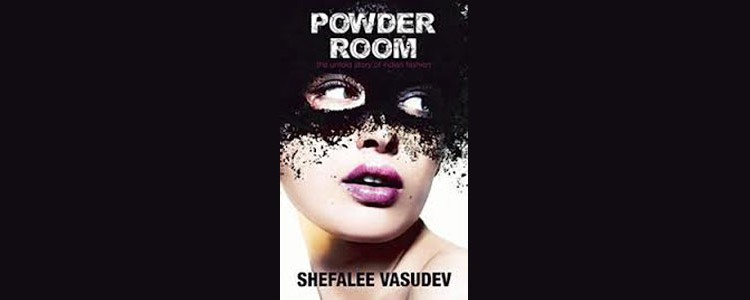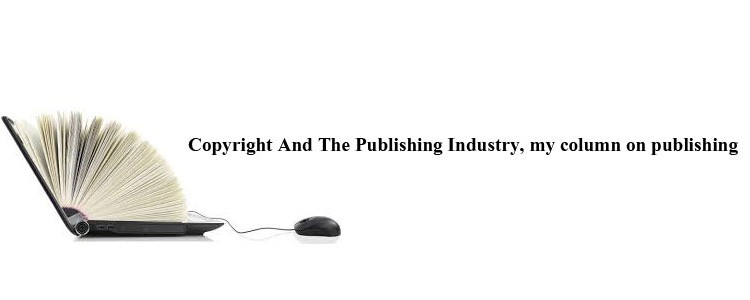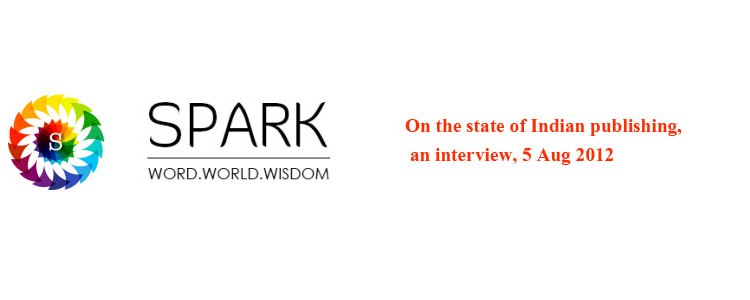http://www.sparkthemagazine.com/?p=4379
The Indian Publishing Industry: Matured, but Still a Long Way to Go
Posted by spark_editor on Aug 5, 2012 in Anupama Krishnakumar, August, Voices of the Month | 0 comments
In an interview to Spark, Jaya Bhattacharji Rose, publishing consultant and columnist talks to Anupama Krishnakumar about interesting trends in the Indian publishing industry including the popularity that commercial fiction is enjoying in India these days, the growing trend of buying books online and the advent of e-books in the Indian market.
Jaya Bhattacharji Rose is an independent international publishing consultant and columnist based in New Delhi. She has been associated with publishing since the early 1990s. Her responsibilities have included guest editing the special Children’s and YA Literature of The Book Review, and producing the first comprehensive report on the Indian Book Market for the Publisher’s Association, UK. Her extensive editorial experience includes stints with Zubaan, Routledge, and Puffin. Her articles, interviews and book reviews have also appeared in Frontline, The Book Review, DNA, Outlook, the Hoot, The Hindu, Hindustan Times, Brunch, LOGOS, Business World, Housecalls and The Muse. She also has a fortnightly column on publishing in Businessworld online and a bi-monthly column in Books & More. She is also advisor to Publishing Next and was advisor to the Federation of Indian Chambers of Commerce and Industry (FICCI) for their conference “Business of Publishing” (Sept 2011).
Jaya Bhattacharji Rose
You have been associated with the publishing industry for about two decades now. How would you describe the journey of the Indian publishing scene from the early 90s to today?
In two decades the industry has transformed considerably. There is a significant amount of professionalism that has come into the industry. It is immaterial if it is a big or a small or an independent publishing house, all of them have recognised the need to have departments for specific requirements, rather than expect one person/department to multi-task. Processes are better organised. The quality of books has improved. The range of publishing services – printing, editing, typesetting, translations, transcripts, design and layouts, self-publishing, vendors offering digital publishing services, book publicists, social media marketing – have increased tremendously to cater to the domestic and international markets.
So, definitely, it has matured, but we still have a long way to go.
There are many books, particularly works of fiction, flooding the Indian market these days. Many publishing houses have come up and we see young first-time authors climbing to the top of bestseller charts. Amidst all this, a section of book lovers feel that ‘proper literary writing’ isn’t getting its due. What are your thoughts?
First it is always important to assess the parameters of the “bestseller” charts. But assuming that these bestseller charts are an accurate picture of the market, then yes, it is true that many first-time authors are doing exceptionally well. Ravinder Singh has crossed the 200,000 unit sales in seven months with his Metro Reads title. But literary fiction or ’proper literary writing,’ as you term it, does still exist. It is simply snowed under with the deluge of first-time authors who have never had it so good –so many publishers. Within a few years this too will settle down. Right now the finer distinctions in the lists are not very apparent, but a) you never know where and when the gems are hidden and b) these books, many of which have a plot that is conversation driven, are catering to and discovering markets so far unheard of. Maybe in a few years we will see a pattern emerging in reading tastes and distinct markets being created.
Historic fiction is fast becoming an extremely popular genre in India now, with works of Ashwin Sanghi and Indu Sundaresan being some fine examples. What do you think could be the reason for this interesting trend?
Historical fiction is not a new trend. Like science fiction, speculative fiction and graphic novels, it is an eco-system that has always existed with a steady base of readers. It is only now that Indian authors like those that you mention are coming into their own.
While works of fiction seem to be selling like hot cakes, what are your thoughts on the non-fiction scene in India?
Indians writing non-fiction is not exactly on the upswing, at least in my opinion. It is yet to grow, but there are enough indications to say that the future will be brighter in this segment. Having said that, I think this genre will take a while to come into its own, given that it requires a fair amount of research, determination and an aptitude for analysis, as well as strong skills of storytelling to produce a fine piece of non-fiction. A stodgy book (although well-documented) is in equal danger of sinking as much as a poorly-researched but well-written one. For me a fine benchmark has been set by Shefalee Vasudev’s Powder Room and Ruchir Sharma’s Breakout Nations. Hopefully there are more in the pipeline.
The readership for Indian non-fiction is definitely on the rise, tremendously so. But if all the categories of fiction are clubbed together then they outstrip that of non-fiction. The readership for non-fiction, specifically business, comes second by value (after general fiction). But in terms of volume, it is probably the MBS (Mind, Body, Spirit) genre that tops the list, even surpassing fiction. Yet it remains low on the classification by value since these books are very reasonably priced. The market will only allow these books to be priced at an average of Rs. 50-60.
As someone who reviews books, what are the important characteristics you look out for in a book to mark it ‘worth a read’?
For me a book should be readable. It should be sustained, good reading till the last page. I want to be satisfied with what I have read and not feel cheated at having spent my money on something that is not worth it at all. The grammar should be perfect. Even if you make allowances for minor errors, the characters and plot lines should be satisfying and not insipid, weak or flat. Creating a weak character in a book is actually quite a tough task, but a flat character is easily achieved, if not much thought is given to the process. The internal logic of the plot should hold together well. Today it is quite easy to verify a reference by checking for it on the Internet.
Does the Indian book market differ in significant ways from the book market in say, the U.S. and the UK? Could you tell us how?
Yes, it does in many ways. Most significantly, those are purely one language (English) speaking and homogenised markets, whereas India consists of many markets within one. This holds true even for the sale of English-language books. You cannot have the same blanket strategy applicable to all regions of the country. These need to be tweaked according to regional tastes and appetites. Plus, this is a country that consists of readers who are at least literate in two (if not more) languages. Hence, they can access literature in whichever language they are most comfortable in. Another point of difference is that the Indian book market is growing rapidly in print and electronic formats. In the U.S. and the UK, the print market has reached saturation levels.
Online portals in India are making great progress, helping customers order books with the click of a mouse and shipping the books to their doorstep. We have recently also seen some bookstores shutting down in the wake of this development. Do you feel that the growing popularity of online bookstores signals the end of the traditional ones?
No. An online retail service is not an online bookstore, for I think buying books online is not akin to buying books in a bookstore. The two experiences are diametrically opposite, although the service is the same. In fact, recent studies say that the brick-and-mortar stores are a necessity, since customers like to immerse themselves in the experience of browsing and discovering books (this is not the same thing as searching online via Google Books.) But then they prefer to buy from online portals (after checking the prices) since these offer discounts. And yes, traditional bookstores and even recent chains will shut down. This is not to be linked completely to the emergence of online retail. Other factors impacting the poor performance of bookstores, especially the chains, are the high rents to be paid, salaries, ill-informed staff, poorly stocked shelves with haphazard display of titles, shoddy information retrieval from computer systems and the sheer lack of knowledge, enthusiasm and passion for books, genres etc., among the staff. Hence recommendations are not easily forthcoming. This is quite unlike traditional bookshops where it is usually the store owner who knows his customers and their literary tastes, is able to recommend titles and establishes a rapport. So in a sense these “corrections” or shutting down of stores in the supply system are inevitable. But some of the traditional landmarks in bookselling in India have shut down because the younger generations were reluctant to enter the business. So it is a tough question to answer.
Another interesting story when we talk about publishing is the advent of e-books. Penguin India too had recently announced its foray into e-books. What do you feel is the scope for the e-book market in India and what is the sort of impact you feel e-books will have on the print book space?
The scope for e-books is tremendous in India. The recent announcement of the Young Creative Entrepreneur Award by the British Council for publishing being given to Jagdish Repasawal for mangoreader.com merely confirms this. E-books are scheduled to take off in a big way. There are already many people/publishers exploring this option. The readers are there. The point to ask is does India have the requisite infrastructure? Do we have sufficient smartphone or iPad penetration in this country to facilitate the boom for e-books? More importantly, at what costs are these services being offered? Will the apps, the books, etc., for the immersion in digital publishing be cost-effective? Studies abroad have shown that creating a digital experience means a huge investment for the publisher, but there is reluctance by the consumer/reader to pay even 30% more to avail of the experience. Plus, in a country like ours where we have a “special Indian price” on the printed book, which is a reasonable price, would a consumer actually avail of the digital experience? And this in a country where reading for leisure is only just about taking off. Maybe the scenario will change once Flipkart makes its e-book programme available country-wide. Also with the entry of Amazon, it is being said that in all probability an Indian edition (read cheaper version) of Kindle may be launched here soon. All these factors may make the environment conducive for an accelerated growth in e-reading.
We have moved away from times where there were just three or four prominent publishing houses. Today, there are a host of new publishing houses that have sprung up, throwing the doors open to more authors and more reading content. I would like to know what your thoughts are about the editing standards of such upcoming and lesser known publishing houses in India.
A mushrooming of publishing houses does not mean an improvement in editorial expertise. The editorial standards are still not 100% perfect. But in any case many publishing houses (whether in India or abroad) prefer to work with freelancers rather than in-house staff. Hence to monitor and enforce quality is not always easily done. Finally editors cannot be trained in the job. Many actually are required to have an inherent feel and passion for their subject. A lot of their editorial skills depends on how much they have read (and continue to do so), how sensitive they are in listening to others, especially their authors, and how willing they are to be a part of a constructive engagement with the author.
Lastly, where do you see the Indian book market heading from here, say over the next ten years?
Oh! No one can even predict what is going to happen six months down the line. The industry is in that much of a flux. So ten years is really far too long. But in a decade hopefully there will be a streamlining of operations from evaluation of a manuscript to production, distribution, selling and marketing etc.
 Early in August I met Krishna Udayasankar in Delhi. She was here for the launch of her debut novel, Govinda. Krishna is a lawyer and based in Singapore, living with her husband and two huskies. She writes although she has a day job as a lecturer at Nanyang Business School. She has a PhD in Business (Strategic Management). According to her, “I write whenever I can – i.e. any available moment. My typical ‘work’ day starts around noon (unless I have classes or meetings in the morning) after a round at the gym, and it goes on past midnight. Of this day, whatever time is not spent on teaching, prep and other university-related duties I try to write, or do research and other things book-related. But lest I sound too hard-working, let me confess that I spend a lot of this time online on FB or mail, passing it off as ‘work’, I do however try to write every day, even for just a few minutes, as a matter of discipline.”
Early in August I met Krishna Udayasankar in Delhi. She was here for the launch of her debut novel, Govinda. Krishna is a lawyer and based in Singapore, living with her husband and two huskies. She writes although she has a day job as a lecturer at Nanyang Business School. She has a PhD in Business (Strategic Management). According to her, “I write whenever I can – i.e. any available moment. My typical ‘work’ day starts around noon (unless I have classes or meetings in the morning) after a round at the gym, and it goes on past midnight. Of this day, whatever time is not spent on teaching, prep and other university-related duties I try to write, or do research and other things book-related. But lest I sound too hard-working, let me confess that I spend a lot of this time online on FB or mail, passing it off as ‘work’, I do however try to write every day, even for just a few minutes, as a matter of discipline.”







